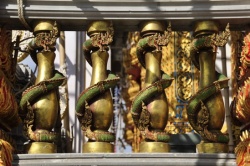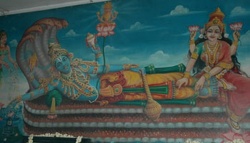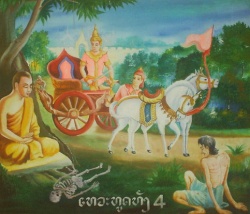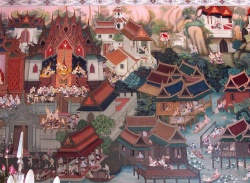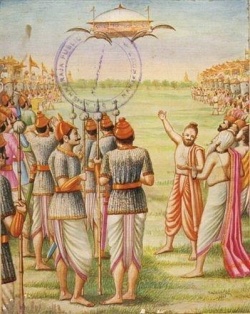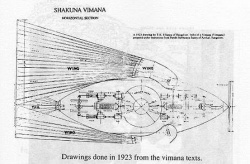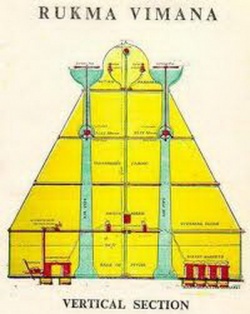Vimāna
Vimāna is a word with several meanings ranging from temple or palace to mythological flying machines described in Sanskrit epics.
Etymology and usage
Sanskrit विमान vi-Māna literally means "measuring out, traversing" or "having been measured out". It can refer to (ref Monier-Williams ):
The palace of an emperor or supreme monarch
The adytum of a Rama temple, or of any other temple
A temple or shrine of a particular Form, see Vimanam (tower)
From that meaning, "a God's palace"
From that meaning Pushpaka or Dandumonara; the flying machine (flying palace) of king Rāvana of Lanka.
From that, a chariot of the Gods, any mythical self-moving aerial car (sometimes serving as a seat or throne, sometimes self-moving and carrying its occupant through the air; other descriptions make the Vimana more like a house or palace, and one kind is said to be seven stories high).
From that, any chariot or vehicle (especially a bier)
In medicine, the science of (right) measure or proportion (e.g. of the right relation between the humours of the Body, of medicines and remedies etc.)
In the Vimanavatthu, a small piece of text used as the inspiration for a Buddhist sermon.
In some modern Indian languages, vimāna or vimān means "aircraft", for example in the town name Vimanapura (a suburb of Bangalore).
In Sanskrit literature
Vedas
The predecessors of the flying Vimanas of the Sanskrit epics are the flying chariots employed by various Gods in the Vedas: the Sun (see Sun chariot) and Indra and several other Vedic Deities are transported by flying wheeled chariots depicted to be pulled by Animals, usually horses.
The Rigveda does not mention Vimanas, but verses RV 1.164.47-48 have been taken as evidence for the idea of "mechanical birds":
47. kṛṣṇáṃ niyânaṃ hárayaḥ suparṇâ / apó vásānā dívam út patanti
tá âvavṛtran sádanād ṛtásyâd / íd ghṛténa pṛthivî vy ùdyate
48. dvâdaśa pradháyaś cakrám ékaṃ / trîṇi nábhyāni ká u tác ciketa
tásmin sākáṃ triśatâ ná śaṅkávo / 'rpitâḥ ṣaṣṭír ná calācalâsaḥ
"Dark the descent: the birds are golden-coloured; up to the Heaven they fly robed in the waters.
Again descend they from the seat of Order, and all the Earth is moistened with their fatness."
"Twelve are the fellies, and the Wheel is single; three are the naves. What man hath understood it?
Therein are set together spokes three hundred and sixty, which in nowise can be loosened." ("trans." Griffith)
In Swami Dayananda Saraswati's "translation", these verses become:
"jumping into space speedily with a craft using Fire and water ... containing twelve stamghas (pillars), one Wheel, three machines, 300 pivots, and 60 instruments."
although the 'Wheel' is likeliest a metaphorical description of the yearly cycle, and '12' and the '360' are likeliest its months and days.
Ramayana
In the Ramayana, the pushpaka ("flowery") Vimana of Ravana is described as follows:
"The Pushpaka chariot that resembles the Sun and belongs to my brother was brought by the powerful Ravana; that aerial and excellent chariot going everywhere at will .... that chariot resembling a bright cloud in the sky ... and the King [[[Wikipedia:Rama|Rama]]] got in, and the excellent chariot at the command of the Raghira, rose up into the higher atmosphere.'"
It is the first flying Vimana mentioned in Hindu mythology (as distinct from the Gods' flying Horse-drawn chariots).
Pushpaka was originally made by Vishwakarma for Brahma the Hindu God of creation, later Brahma gifted it to Kubera, the God of Wealth, but was later stolen, along with Lanka, by his half-brother, the demon king Ravana.
Mahabharata
One example in the Mahabharata is that the Asura Maya had a Vimana measuring twelve cubits in circumference, with four strong wheels.
The Mahabharata compliments "the all-knowing Yavanas" (sarvajnaa yavanaa), as the creators of the Vimanas: The Yavanas, O king, are all-knowing; the Suras are particularly so (sarvajnā yavanā rajan shurāz caiva vishesatah).
Jaina literature
Vimāna-vāsin ('dweller in vimāna') is a class of Deities who served the tīrthaṃkara Mahā-vīra. These Vaimānika Deities dwell in the Ūrdhva Loka heavens.
According to the Kalpa Sūtra of Bhadra-bāhu, the 24th tīrthaṃkara Mahā-vīra himself emerged out of the great vimāna Puṣpa-uttara; whereas the 22nd tīrthaṃkara Ariṣṭa-nemi emerged out of the great vimāna Aparijita. The tīrthaṃkara-s Abhinandana (4th) and Sumati-nātha (5th) both traveled through the sky in the "Jayanta-vimāna", namely the great vimāna Sarva-artha-Siddhi, which was owned by the Jayanta Deities; whereas the tīrthaṃkara Dharma-nātha (15th) traveled through the sky in the "Vijaya-vimāna".
A vimāna may be seen in a dream, such as the nalinī-gulma.
Vimanas and the Vaimanika Shastra
An illustration of the Shakuna Vimana that is supposed to fly like a bird with hinged wings and tail.
The Vaimānika Shāstra is an early 20th century Sanskrit text on aeronautics, obtained allegedly by Mental channeling, about the construction of Vimānas, the "chariots of the Gods".
The existence of the text was revealed in 1952 by G. R. Josyer, according to whom it is due to one Pandit Subbaraya Shastry, who dictated it in 1918–1923. A Hindi translation was published in 1959, the Sanskrit text with an English translation in 1973. It has 3000 shlokas in 8 chapters and was attributed by Shastry to Maharishi Bharadvaja, which makes it of purportedly "ancient" origin, and hence it has a certain notability in ancient astronaut theories.
A study by aeronautical and mechanical engineering at Indian Institute of Science, Bangalore in 1974 concluded that the aircraft described in the text were "poor concoctions" and that the author showed complete lack of understanding of aeronautics.
In popular culture
Vimanas have appeared in Books, films, internet and games including:
Grant Morrison's Vimanarama features Vimanas.
Vimana is an arcade game from Toaplan wherein the player's ship earns the name.
Interstellar propulsion system called "Vimana Drive" is used in the space exploration game Noctis
The psy-trance producers Etnica released 'Vimana' in 1997 with samples drawn from the film 'Roswell', which includes references to UFOs and alien Life forms.
Gouryella, a former trance duo, used Vimana as one of their aliases.
In Fate/zero, Archer has a Vimana in his arsenal.
In The Objective, a US Special Forces ODA searches for Vimanas in Afghanistan
In the game Deep Labyrinth, the labyrinth is referred to as Vimana by its caretakers.
There was a Brazilian progressive rock group (1974–1979) called Vímana (stress on the first syllable) that, in spite of achieving little success, is particularly interesting because three of its former members later became music stars in Brazil: Lobão (drummer), Ritchie (bassist), Lulu Santos (guitarist/vocalist). The band also had in its ranks, for two years (1977/1979), Swiss keyboardist Patrick Moraz, then fresh from Yes. They issued one record, in 1976, and disbanded shortly after finishing recording the second.
Michael Scott (Irish author) wrote The Secrets of the Immortal Nicholas Flamel, a fantasy series that included flying Vimanas in the later Books.
Mainak Dhar wrote Vimana, a fantasy fiction novel.
The album Space & Time released in 2000 by the Canadian neo-psychedelic band Orange Alabaster Mushroom features a track called "Aim the Vimana Toward the Dorian Sector".
Vimāna1 (nt.) [in the Pāli meaning not Vedic. Found in meaning "palace -- chariot" in the Mbhārata and elsewhere in Epic Sk.] lit. covering a certain space, measuring; the defns given by Dhpāla refer it to "without measure," i. e. immeasurable. Thus=vigata -- māne appamāṇe mahanta vara -- pāsāda VvA 131;=visiṭṭhamānaŋ, pamāṇato mahantaŋ VvA 160. -- Appld meaning: heavenly (magic) palace, a kind of paradise, elysium. -- 1. General remarks: (a) The notion of the vimāna is peculiar to the later, fantastic parts of the Canon, based on popular superstition (Vimāna & Peta Vatthu, Apadāna, Jātaka and similar fairy tales). It shows distinct traces of foreign (Hellenic -- Babylonian) influence and rests partly on tales of sea -- faring merchants (cp. location of V. in mid -- ocean). On the other hand it represents the old (Vedic) ratha as chariot of the gods, to be driven at will (cp. below 5, 7, 8).
Thus at Vv 16 (here as 500 chariots!), 36, 63, 64; J i.59 (deva -- vimānasadisa ratha). -- (b) The vimānas are in remote parts of the world (cp. the island of the blessed), similar to the elysium in Homer's Odyssey, e. g. iv.563 sq.: s)e)s *)hlu/sion pedi/on kai\ pei/rata gai/hs a)qa/natoi pemyousin etc. (trsln G. Chapman: "the immortal ends of all the earth, the fields Elysian Fate to thee will give; where Rhadamanthus rules, and where men live a nevertroubled life, where snow, nor show'rs, nor irksome winter spends his fruitless pow'rs, but from the ocean zephyr still resumes a constant breath, that all the fields perfume"). Cp. Ehni, Yama p. 206 sq. -- (c)
In popular religion the influence of this eschatological literature has been very great, so great in fact as to make the Vimāna and Peta -- vatthus & the Jātakastories, exemplifying the theory of retribution as appealing to an ordinary mind by vivid examples of mythology, greater favourites than any other canonical book. From this point of view we have to judge Mhvs 14, 58: Petavatthuŋ Vimānañ ca sacca -- saŋyuttaŋ eva ca desesi thero . . .
-- 2. The descriptions of the Vimānas are in the most exuberant terms. The palaces (kingdoms in miniature) are of gold, crystal or exquisite jewels, their pillars are studded with gems, their glittering roofs are peaked with 700 pinnacled turrets (VvA 244, 289; also as "innumerable" VvA 188, or 18,000 Ap. 63).
Surrounded are these towering (ucca) mansions by lovely, well -- planned gardens, the paths of which are sprinkled with gold dust; they are full of wishing -- trees, granting every desire. There is a variety of stately trees, bearing heavenly flowers & fruit, swaying gently in delicious breezes. Lotus ponds with cool waters invite to refreshing baths; a host of birds mix their songs with the strains of cymbals and lutes, played by heavenly musicians. Angelic maidens perform their dances, filling the atmosphere with a radiant light which shines from their bodies. Peace and happiness reign everywhere, the joys of such a vimāna cannot be expressed in words. This elysium lasts for aeons (cira -- ṭṭhitika Vv 801, kappa -- ṭṭhāyin Th 1, 1190); in short it is the most heavenly paradise which can be imagined. --
For a monograph of vimāna the Vimāna Vatthu and its Commentary should in the first place be consulted.
-- 3. The inhabitants of the Vimānas are usually happy persons (or yakkhas: see Stede, P. V. trsl. 39 -- 41), called devatā, who have attained to such an exalted state through their own merit (puñña see foll. 4).
-- Departed souls who have gone through the Petastage are frequently such devas (at Vv 172 called pubbadevatā). That these are liable to semi -- punishment and semi -- enjoyment is often emphasized, and is founded on the character of their respective kamma: J i.240 (vimāna -- petiyo sattāhaŋ sukhaŋ anubhavanti, sattāhaŋ dukkhaŋ); J v.2 (vemānika -- peta -- bhavena -- kammassa sarikkhako vipāko ahosi; i. e. by night pleasures; by day tortures); cp. Pv ii. 12 (see Stede, Gespenstergeschichten des Peta Vatthu p. 106), iii. 78; PvA 204, 210, & Divy p. 9. Expressions for these "mixed" devatās who are partly blessed, partly cursed are e. g.: vimānapeta PvA 145, 148, 271, 275; f. vimāna -- petī PvA 152, 160, 186, 190; vimāna devatā PvA 190; vemānika -- peta J v.2; PvA 244; DhA iii.192 (as powerful, by the side of nāgas & supaṇṇas). -- In their appearance they are like beautiful human beings, dressed in yellowish (pīta, expld as "golden" robes (cp. the angels in the oldest Christian apocalyptic literature: on their relation to Hellenic ideas see e. g. A. Dieterich, Nekyia, Leipzig 1903, pp. 10 -- 18, 29: red & white the colours of the land of the blessed), with gold and silver as complementary outfit in person and surroundings. Thus throughout the Vimāna Vatthu, esp. Nos, 36 & 47 (pīta -- vimāna).
Their splendour is often likened to that of the moon or of the morning star. -- 4. Origin of Vimānas. A vimāna arises in the "other world" (paraloka) at the instant of somebody doing good (even during the lifetime of the doer) and waits for the entry of the owner: DhA iii.291 sq. In the description of the vimāna of the nāga -- king (J vi.315=Vv 8422) it is said on this subject: a vimāna is obtained neither without a cause (adhicca), nor has it arisen in the change of the seasons, nor is it self -- made (sayankata), nor given by the gods, but "sakehi kammehi apāpakehi puññehi laddha" (i. e. won by one's own sinless & meritorious deeds). --
Entering the Vimāna -- paradise is, analogous to all semi -- lethal passing over into enchanted conditions in fairy tales, compared with the awakening from sleep (as in a state of trance): sutta -- ppabuddha DhA iii.7. Of the Vimāna itself it is said that it appears (pātur ahosi), e. g. VvA 188; DhA i.131; or arises (uggañchi) DhA iii.291; VvA 221. -- 5. Location of the Vimānas. The "vimāna" is an individual paradisiacal state Therefore vimānas are not definitely located "Elysian Fields." They are anywhere (in this world as well as in the Beyond), but certain places are more favourable for their establishment than others.
Thus we may state that kat) e)coxh/n they are found in the neighbourhood of water. Thus either in the Ocean (majjhe sāgarasmiŋ Th 1, 1190; samudda -- majjhe PvA 47), where access is possible only through adventures after shipwreck or similar causes (J. iv.1 sq.; Pv iv.11); or at one or the other of the great lakes of the Himavant (Pv ii.12). They are in out -- of -- the -- way places ("end of the world"); they are also found in the wilderness: Vv 84; Pv iv.32. As tree -- vimānas with rukkha -- devatā as inhabitants they occur e. g. at J iii.310; v.502; Pv i.9; ii.9; PvA 244. Very often they are phantasmagorical castles in the air. By special power of their inhabitants they may be transported to any place at will.
This faculty of transference is combined with the ability of extremely swift motion (compared to the speed of thought: manojava). Thus a golden palanquin is suspended in mid -- air above a palace at VvA 6 (ākāsa -- cārin, sīgha -- java). They are said to be ākāsaṭṭhānāni J vi.117; SnA 222, 370 (but the palace of the Yakkha Āḷavaka is bhumma -- ṭṭha, i. e. stands on the ground, and is described as fortified: SnA 222). The place of a (flying) vimāna may be taken by various conveyances: a chair, an elephant, ship, bed, litter etc. Or the location of it in the other world is in the Cittalatāvana (Vv 37), or the Pāricchattaka tree (Vv 38), or in the Cātummahārājika -- bhavana (VvA 331). -- Later on, when the theory of meritorious deities (or departed souls raised to special rank) as vemānikā devā was established, their abode was with their vimānas settled among the Tāvatiŋsa (e. g. VvA 188, 217, 221, 244, 289; DhA iii.291), or in the Tusita heaven.
Thus Tusita -- pura interchanges with Tusita -- vimāna at DhA ii. 208. The latter occurs e. g. at DhA iii.173, 219. <-> 6. The dimensions of the Vimānas are of course enormous, but harmonious (being "divine"), i. e. either of equal extent in all directions, or specially proportioned with significant numbers. Of these the foll. may be mentioned. The typical numbers of greatest frequency are 12, 16, 30, 700, in connection with yojana. The dimensions, with ref. to which 12 & 16 are used, are length, width, height, & girth, whereas 700 applies usually to the height (DhA iii 291 e. g., where it is said to be "over 700"), and the number of turrets (see above 2). At VvA 267 (satta -- yojana -- pamāṇo ratho) No. 7 is used for 700; No. 30 (extent) is found e. g. at DhA iii.7; ThA 55; No. 12 e. g. at J vi.116; DhA iii.291; VvA 6, 217, 221, 244, 246, 291 sq.; No. 16 at VvA 188, 289. -- 7.
Vimānas of sun and moon. A peculiar (late?) idea is that sun and moon have their vimānas (cp. Vedic ratha=sun). There are only very few passages in the post -- canonical books mentioning these. The idea that the celestial bodies are vimānas ("immense chariots in the shape of open hemispheres" Kirfel, Kosmographie der Inder p. 282) is essentially Jainistic. See on Jain Vimānas in general Kirfel, l. c. pp. 7 -- 9, 292 -- 300. -- In the Pāli Com. we find SnA 187, 188 (canda -- vimānaŋ bhinditvā=breaking up the moon's palace, i. e. the moon itself); and DhA iii.99 (candimasuriyā vimānāni gahetvā aṭṭhaŋsu). -- 8. Other terms for vimāna, and specifications. Var. other expressions are used more frequently for vimāna in general. Among these are ratha (see above 1 a); nagara (Pv ii.125); pura (see above 5, as tusita˚); pāsāda; either as dibba˚ (DhA iii.291), or vara˚ (VvA 130), or vimāna˚ (Vv 3110). --
The vimānas are specified as deva -- vimāna "heavenly palace," e. g. J i.59; Vism 342; VvA 173; or (in a still more superlative expression) brahmavimāna, i. e. best or most excellent magic palace, highest paradise, e. g. D i.17 (here perhaps "palace of Brahmā"); iii.28 ("abode of brahmās" Rh. D.); It 15; Vism 108. The latter expression is abbreviated to brahma (nt.) "highest, best thing of all," "summum bonum," paradise, magic palace: ThA 47 (Ap. v. 6) & 55 (Ap. v. 8), at both places as sukataŋ, i. e. well made. -- A rather odd expression for the paradisiacal state (in concrete form) is attabhāva (existence, cp. Gr. bioth/ Hom. Od. iv.365?) instead of vimāna, e. g. DhA i.131 (tigāvuta -- ppamāṇa); iii.7 (id.). -- 9. Various. Of innumerable passages in the books mentioned above (under 1) only the foll. may be given for ref.: J iii.310 398, 405; v.165, 171; vi.117 sq., 120 sq.; Ap 35, 55, 59; Dāvs iv.54 (acalaŋ v. antalikkhamhi nāvaŋ gativirahitaŋ ambhorāsi -- majjhamhi disvā); and Vimāna Vatthu throughout. Of passages in the 4 older Nikāyas we have only A ii.33 (ye devā dīgh' āyukā uccesu vimānesu cira -- ṭṭhitikā). At S i.12=23 we should read "na ca mānaŋ" for "na vimānaŋ" (K.S. i.18).
